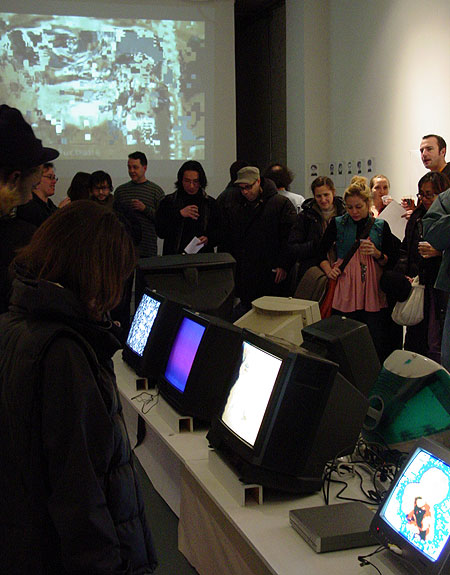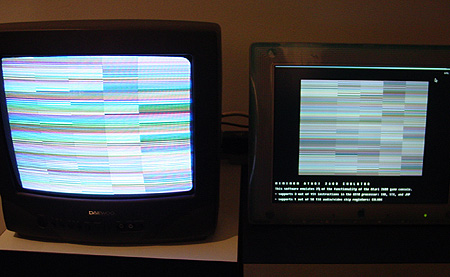


...at vertexList. Top photo: the projection on the rear wall is Paul B. Davis/Paper Rad's Video Compression Study II, interpolating Rihanna (I think), the Cranberries, and assorted '80s VHS ephemera. My "Stock Popcorn" GIF, based on a stock footage video of a rotating popcorn kernel found by Guthrie Lonergan, is in the foreground--from an "enlarged GIFs collection" vid I burned to DVD for the show. The bottom image and detail is a rather handsome work by Paul Slocum--the description reads "MINIMUM ATARI 2600 EMULATOR. This software emulates 2% of the functionality of the Atari 2600 game console. Supports 3 out of 151 instructions in the 6510 processor: INX, STX, and JMP. Supports 1 out of 58 TIA audio/video chip registers: COLUBK"
The Atari console is on the floor, connected to the left hand screen; a PC is connected to the screen on the right. I'm guessing the joke is that the console image is set at the same minimal level of information as the emulator--a kind of pre-emptive subtraction to avoid the usual XYZ reading of this kind of transformation.
Slocum adds (via email):
...I thought [the minimum emulator] needed to demonstrate some sort of verifiable output and use the simplest command subset to do so. I chose INX (increase the X register by one), STX (store the X value in a memory location), and JMP (like GOTO in BASIC, need this to keep it running in a loop).
So the program that both the emulator and Atari are running is made up of a long string of alternating INX and STX commands with a JMP at the end to make it loop. I probably spent more time designing the sequence* than I did writing the emulator.
At this level of minimalism in code and machine, I noticed that it reduces to a variation on the concept of [Steve Reich's] "It's Gonna Rain." Its visual complexity is due to mismatched phase. I may explore this further in future work...
*A .pdf showing the "Atari 2600 ROM Disassembler Output" is here.
